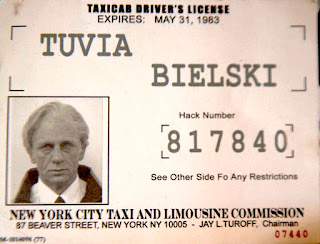 Over 80 years ago, on the eve of Leah Bedzowski Johnson's 18th birthday, the Nazis invaded her hometown of Lida, located in the eastern half of Poland. At this time, Leah's father had just passed away, and her family was in mourning. With the arrival of the Nazis and the antisemitic policies they imposed, many more challenges lay ahead for the family.
Over 80 years ago, on the eve of Leah Bedzowski Johnson's 18th birthday, the Nazis invaded her hometown of Lida, located in the eastern half of Poland. At this time, Leah's father had just passed away, and her family was in mourning. With the arrival of the Nazis and the antisemitic policies they imposed, many more challenges lay ahead for the family.Leah, with her mother Chasia, and her three younger siblings Charles, Sonia, and Benjamin, tried early on to escape from their oppressors. They were taken in by sympathetic farmers on the outskirts of town where they hid for a short period of time. The state soon decreed that all Jews would be confined in ghettos. The farmers could no longer safely harbor the family, so the Bedzowski Family was forced to return to Lida and imprisoned in the ghetto.
Their passport to freedom arrived in a letter from family friend Tuvia Bielski, encouraging the Bedzowskis to join his brigade in the forest. Tuvia and his brothers had escaped the massacre and were hidden deep in the woods. Determined to save as many Jews as possible, the Bielski group was welcoming all escaped Jews into their encampment.
The Bedzowskis readily accepted Tuvia’s help. Tuvia sent a guide to escort the family out of the ghetto. The group traveled by night in silence, past guard dogs, under barbed wire, and often on their hands and knees. When they reached the forest, their guide told them, “You are going to live.” Leah and her family joined the Bielski Brigade that night.
Leah took on the necessary duties of the encampment including food-finding missions and guard duty. Never safe until the war’s end, Leah and her fellow partisans in the Bielski brigade found themselves fighting and sometimes fleeing the German army. On one occasion, the Bedzowski family were separated from the rest of the group as the German army advanced towards them. As they and a few families despondently sat under a tree, wondering what would become of them, a group of young Jewish partisan men came upon them. One of the men was Velvel “Wolf” Yanson, a Jewish partisan from another brigade. Velvel left his group to become the protector of the Bedzowski family. He helped them return to the Bielski group where he became known as “Wolf the Machine Gunner.” “It is thanks to his fortitude and strength that my mother Chasia, brothers Chonon (Charles) and Benjamin, as well as the other families whom he encountered under the tree, were all saved,” says Leah. “If it wasn’t for him, my family would have perished and the Bedzowski/Bedzow name would have vanished for eternity.”
Velvel and Leah were married under a chuppah (marriage canopy) surrounded by their fellow partisans in the forest. The couple stayed with the Bielski group throughout the war until they were liberated. When the Soviet Army tried to enlist Velvel after the war, the couple decided to leave the country. Fleeing through Hungary, Czechoslovakia, and Austria, they eventually crossed the Alps into Italy, where they remained for four years at a DP camp in Torino. They immigrated to Montreal, Canada in 1949, where they raised 3 children.
Leah lived in Florida, where she was active in the Jewish community and lectured extensively about her Jewish partisan experience. She insisted that not only her grandchildren and great-grandchildren knew her story, but also anyone she could reach out to, especially the younger generation. “Fight for your rights. Know who you are. This is my legacy,” she always said. Leah passed away on December 4, 2019. May her memory be a blessing.
Visit www.jewishpartisans.org for more about Leah Johnson, including five videos of her reflecting on her time as a partisan. Visit jewishpartisans.org/defiance to see JPEF’s short documentary films and educational materials on the Bielski partisans.











